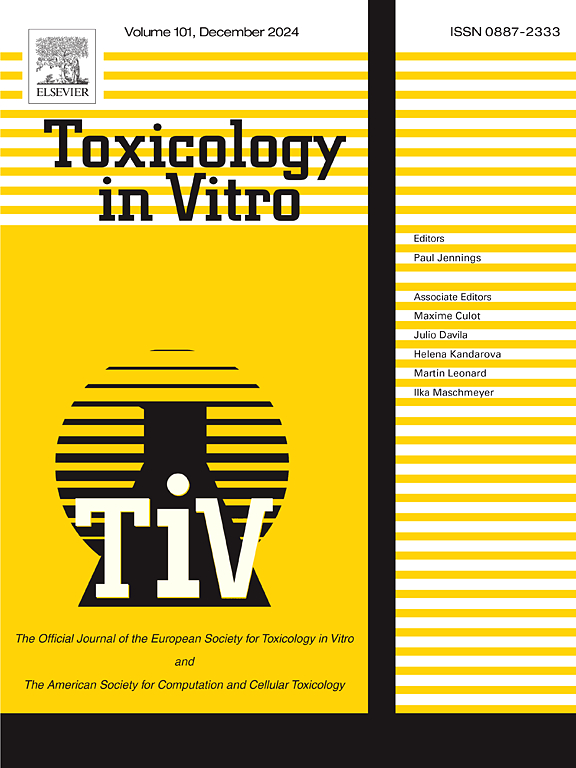A perfused iPSC-derived proximal tubule model for predicting drug-induced kidney injury
IF 2.6
3区 医学
Q3 TOXICOLOGY
引用次数: 0
Abstract
The kidney is frequently exposed to high levels of drugs and their metabolites, which can injure the kidney and the proximal tubule (PT) in particular. In order to detect nephrotoxicity early during drug development, relevant in vitro models are essential. Here, we introduce a robust and versatile cell culture insert-based iPSC-derived PT model, which can be maintained in a microphysiological system for at least ten days. We demonstrate the model's ability to predict drug-induced PT injury using polymyxin B, cyclosporin A, and cisplatin, and observe that perfusion distinctly impacts our model's response to xenobiotics. We observe that the upregulation of metallothioneins that is described in vivo after treatment with these drugs is reliably detected in dynamic, but not static in vitro PT models. Finally, we use our model to alleviate polymyxin-induced nephrotoxicity by supplementing the antioxidant curcumin. Together, these findings illustrate that our perfused iPSC-derived PT model is versatile and well-suited for in vitro studies investigating nephrotoxicity and its prevention. Reliable and user-friendly in vitro models like this enable the early detection of nephrotoxic potential, thereby minimizing adverse effects and reducing drug attrition.
灌注ipsc衍生近端小管模型预测药物性肾损伤。
肾脏经常暴露于高水平的药物及其代谢物中,这可能会损害肾脏,特别是近端小管(PT)。为了在药物开发的早期发现肾毒性,相关的体外模型是必不可少的。在这里,我们介绍了一种健壮且多功能的基于细胞培养插入的ipsc衍生PT模型,该模型可以在微生理系统中维持至少10天。我们使用多粘菌素B、环孢素A和顺铂证明了该模型预测药物性PT损伤的能力,并观察到灌注明显影响我们的模型对外源性药物的反应。我们观察到,在体内用这些药物治疗后,金属硫蛋白的上调在动态的体外PT模型中被可靠地检测到,而不是静态的。最后,我们利用我们的模型通过补充抗氧化剂姜黄素来减轻多粘菌素引起的肾毒性。总之,这些发现表明,我们的灌注ipsc衍生的PT模型是通用的,非常适合于研究肾毒性及其预防的体外研究。像这样的可靠且用户友好的体外模型能够早期发现肾毒性潜能,从而最大限度地减少不良反应并减少药物损耗。
本文章由计算机程序翻译,如有差异,请以英文原文为准。
求助全文
约1分钟内获得全文
求助全文
来源期刊

Toxicology in Vitro
医学-毒理学
CiteScore
6.50
自引率
3.10%
发文量
181
审稿时长
65 days
期刊介绍:
Toxicology in Vitro publishes original research papers and reviews on the application and use of in vitro systems for assessing or predicting the toxic effects of chemicals and elucidating their mechanisms of action. These in vitro techniques include utilizing cell or tissue cultures, isolated cells, tissue slices, subcellular fractions, transgenic cell cultures, and cells from transgenic organisms, as well as in silico modelling. The Journal will focus on investigations that involve the development and validation of new in vitro methods, e.g. for prediction of toxic effects based on traditional and in silico modelling; on the use of methods in high-throughput toxicology and pharmacology; elucidation of mechanisms of toxic action; the application of genomics, transcriptomics and proteomics in toxicology, as well as on comparative studies that characterise the relationship between in vitro and in vivo findings. The Journal strongly encourages the submission of manuscripts that focus on the development of in vitro methods, their practical applications and regulatory use (e.g. in the areas of food components cosmetics, pharmaceuticals, pesticides, and industrial chemicals). Toxicology in Vitro discourages papers that record reporting on toxicological effects from materials, such as plant extracts or herbal medicines, that have not been chemically characterized.
 求助内容:
求助内容: 应助结果提醒方式:
应助结果提醒方式:


